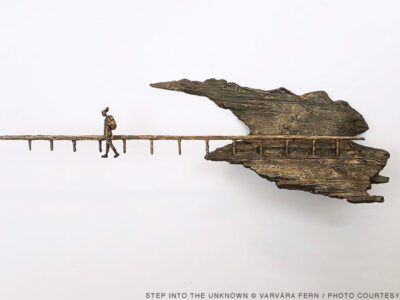

It might be time to count Lowry Burgess FA’61 among the ranks of Neil Armstrong and Edwin “Buzz” Aldrin. No, he’s not an astronaut. But he is the only person on Earth whose art has gone with NASA to outer space and back. Next year his artful payload will land on the moon. And it will stay up there, along with Armstrong’s famous footprints, for a long, long time.
Forget easels, frames, museum plaques. Instead, think molecular compounds, sounds and smells, markings and drawings, poetry, human DNA, and terrestrial elements. Imagine a small, robotic rover traversing the lunar surface, for example. Its wheels are themselves a work of art, designed to imprint the moon dust with a meaningful pattern that can be interpreted both visually and musically. The movement of the rover will also be used to create drawings on the moon, replicas of crowd-sourced submissions voted most popular in the months and years leading up to the mission.
Burgess will make this ultimate art project a reality by sending it moonward on a rocket built by Astrobotic Technology, a private spin-off of the Robotics Institute at Carnegie Mellon University, where he was dean of the College of Fine Arts and is now professor and distinguished fellow in the college’s Studio for Creative Inquiry program. Astrobotic, which was recently selected by NASA to develop robotic teams to explore caves on Mars, the moon, and other planetary destinations, is headed to the moon in competition for the Google Lunar X Prize. (Google is offering a total of $30 million in awards to “the first privately funded teams to safely land a robot on the surface of the moon, have that robot travel 500 meters over the lunar surface, and send video, images, and data back to the Earth.”)
As Astrobotic’s Google Lunar X Prize team was taking shape, Burgess got a call from William “Red” Whittaker, the company’s CEO and a robotics professor at CMU. Whittaker invited him to lead an ancillary team of artists—the Moon Arts Group, Burgess calls them—on the expedition.
Burgess traces his early interest in outer space to the years surrounding the Vietnam War. “I couldn’t understand what we were doing there, which seemed cosmically stupid,” he says. “So that got me off the planet, looking up for a new perspective on where exactly we were on Earth.”
Since then, he has spent much of his career defining and refining his involvement in the creation of Space Art.
“My first major work involved opening the Earth to a geological strata that was the same age as the light coming to it overhead from particular stars,” he says of Starpits Waiting for Light Planes, created in the late 1960s. A few years later, he created Inclined Galactic Light Pond—a hovering holographic lake that he installed in Afghanistan, with the help of a grant from the Guggenheim Foundation.
Burgess, whose many honors include the Leonardo da Vinci Space Art Award from the National Space Society, has been a longtime fellow, senior consultant, and advisor at MIT’s Center for Advanced Visual Studies. In that capacity he’s created and directed a number of large collaborative projects and festivals in the United States and Europe.
“There were a few raised eyebrows” when he first approached NASA with the idea of sending art into space in 1976, he says. Though it would take another 13 years for that idea to take off, his Boundless Cubic Lunar Aperture was chosen as the first non-scientific payload taken into space by NASA.
The piece nearly defies description, admits Burgess:
“It was a very complex work which took 10 years to prepare. The very center is a cubic vacuum chamber, surrounded by walls that are holograms of nothing.” Surrounding those holograms—the making of which “is a story unto itself”—is “another cube half-filled with water gathered from the mouths of the 18 great rivers and 18 other sources. All the trace elements of the periodic table fill the other half of the cube. On the outermost surface of the cube are holograms of poetry. The poems are about release through light and release through darkness … all that we are and everything that is not is flying free from gravity.”
Burgess makes full use of the written word in his work, both to launch the news and as part of the art.
“Our reach into space constitutes an infinite extension of human life, imagination and creativity,” he (and two colleagues and fellow artists) wrote in their “Sky and Space Artists Manifesto,” which he shared with a 1986 UNESCO conference in Paris. “From the ancient past, artists and poets have formed images and dreams, fired the imagination, built structures of aspiration to give the world the wings to fly, and the vision to see new societies in the sky. We live in their cumulative light.”
He says that he wrote his 1987 book, Burgess: The Quiet Axis, “to make a testament to family and friends who speak other languages about the core of my artwork at that time.” The title, he adds, “is meant to imply that there is a different and hidden ‘axis’ of alignment of consciousness, spirit, rotation, and movement within our cosmos—an axis that attaches the Earth to its cosmic matrix, creating a new cosmology that implies a different future for the Earth.” The book won the Imperishable Gold Award from Le Devoirnewspaper in Montreal; his project, The Quiet Axis, continues today as the overarching title of his life’s work.
Burgess does expect that man will one day colonize the moon. But his current passion is to ignite others to engage with the moon today, despite the distance to that dream.
“The public has been shut away from outer space,” he says. “The widespread engagement that existed in the ’60s and ’70s was lost. We need to re-engage; not just for space stations, not just to be in competition with other countries, but because the moon is our nearest neighbor, because we’re all part of the same matrix.”
Four years ago, Burgess joined with the Studio for Creative Inquiry’s Deep Space Signaling Group in a live sound-and-video artwork titled I See the Earth and It Is Beautiful, after the phrase famously spoken by Soviet cosmonaut Yuri Gagarin in 1961. The work, which was part of an event celebrating “Yuri’s Night” at the NASA Ames Research Center in San Francisco and coincided with the 16th expedition of the International Space Station, incorporated recordings of astronauts speaking from space.
NASA may have recently ended its shuttle program, and many may have turned their attention from the sky, but Burgess is determined to continue creating—and communicating—to help us see what he sees.
“When I look up at night,” he says, “I see swarms of life.”
—Rachel Estrada Ryan C’00
To follow the progress of Burgess and Astrobotic as they create and race their way the moon, visit moonarts.org and astrobotic.net, respectively.




